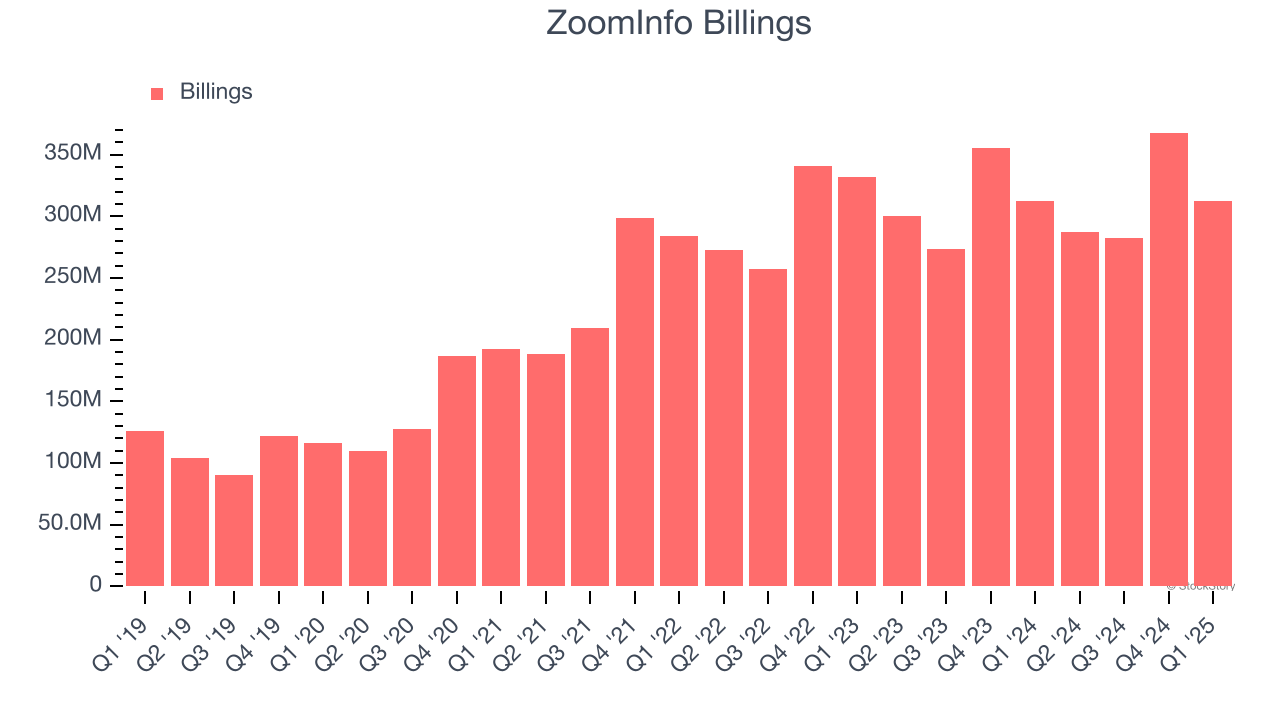
Although the S&P 500 is down 2.4% over the past six months, ZoomInfo’s stock price has fallen further to $10.28, losing shareholders 9.5% of their capital. This might have investors contemplating their next move.
Is there a buying opportunity in ZoomInfo, or does it present a risk to your portfolio? Get the full breakdown from our expert analysts, it’s free.
Why Do We Think ZoomInfo Will Underperform?
Even though the stock has become cheaper, we're sitting this one out for now. Here are three reasons why there are better opportunities than ZI and a stock we'd rather own.
1. Billings Hit a Plateau
Billings is a non-GAAP metric that is often called “cash revenue” because it shows how much money the company has collected from customers in a certain period. This is different from revenue, which must be recognized in pieces over the length of a contract.
Over the last year, ZoomInfo failed to grow its billings, which came in at $312.2 million in the latest quarter. This performance was underwhelming and shows the company faced challenges in acquiring and retaining customers. It also suggests there may be increasing competition or market saturation. 
2. Long Payback Periods Delay Returns
The customer acquisition cost (CAC) payback period represents the months required to recover the cost of acquiring a new customer. Essentially, it’s the break-even point for sales and marketing investments. A shorter CAC payback period is ideal, as it implies better returns on investment and business scalability.
ZoomInfo’s recent customer acquisition efforts haven’t yielded returns as its CAC payback period was negative this quarter, meaning its incremental sales and marketing investments outpaced its revenue. This inefficiency partly stems from its focus on enterprise clients who require some degree of customization, resulting in long onboarding periods that delay customer spending.
3. Shrinking Operating Margin
While many software businesses point investors to their adjusted profits, which exclude stock-based compensation (SBC), we prefer GAAP operating margin because SBC is a legitimate expense used to attract and retain talent. This is one of the best measures of profitability because it shows how much money a company takes home after developing, marketing, and selling its products.
Looking at the trend in its profitability, ZoomInfo’s operating margin decreased by 10.3 percentage points over the last year. This raises questions about the company’s expense base because its revenue growth should have given it leverage on its fixed costs, resulting in better economies of scale and profitability. Its operating margin for the trailing 12 months was 8.7%.

Final Judgment
We see the value of companies addressing major business pain points, but in the case of ZoomInfo, we’re out. Following the recent decline, the stock trades at 2.9× forward price-to-sales (or $10.28 per share). This valuation multiple is fair, but we don’t have much confidence in the company. There are better stocks to buy right now. We’d suggest looking at one of our all-time favorite software stocks.
Stocks We Would Buy Instead of ZoomInfo
Market indices reached historic highs following Donald Trump’s presidential victory in November 2024, but the outlook for 2025 is clouded by new trade policies that could impact business confidence and growth.
While this has caused many investors to adopt a "fearful" wait-and-see approach, we’re leaning into our best ideas that can grow regardless of the political or macroeconomic climate. Take advantage of Mr. Market by checking out our Top 9 Market-Beating Stocks. This is a curated list of our High Quality stocks that have generated a market-beating return of 183% over the last five years (as of March 31st 2025).
Stocks that made our list in 2020 include now familiar names such as Nvidia (+1,545% between March 2020 and March 2025) as well as under-the-radar businesses like the once-micro-cap company Kadant (+351% five-year return). Find your next big winner with StockStory today.

